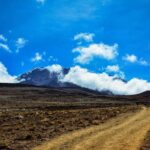Nested within a country known for its rich wildlife and majestic landscapes are Tanzania’s hidden waterfalls, treasures often overshadowed by the Serengeti and Mount Kilimanjaro. These cascading wonders offer intimate encounters with nature, far from the usual tourist trails. If you seek serenity and untouched beauty, Tanzania’s waterfalls are your haven.
Historically, Tanzania’s waterfalls have remained relatively undiscovered, preserving their pristine condition. Among the most famous is the Materuni Waterfall, near Moshi, standing at an impressive 150 meters high. For those interested in unique ecological sites, the Sanje Waterfalls in the Udzungwa Mountains National Park, with its rich biodiversity, are a compelling destination, demonstrating the need to prioritize natural conservation.
Tanzania’s Waterfalls: Hidden Natural Beauties Worth Visiting
Tanzania’s waterfalls, such as the stunning Materuni and Sanje Waterfalls, are hidden gems waiting to be explored. They are located in secluded areas, making them perfect for adventurers who love the serenity of nature. The Materuni Waterfall, for instance, is nestled near the foothills of Mount Kilimanjaro. You can enjoy a scenic hike through coffee plantations to reach it. This journey rewards you with breathtaking views and the soothing sounds of cascading water.
Apart from their beauty, these waterfalls are a haven for diverse flora and fauna. You can find unique species of birds and plants, making it a paradise for nature lovers. The Udzungwa Mountains, home to the Sanje Waterfalls, offer a rich biodiversity. The forest surrounding the falls hosts rare primates like the Iringa red colobus. Exploring these areas allows you to connect deeply with the natural world.
Visiting these waterfalls also has a positive impact on local communities. Eco-tourism in these regions supports conservation efforts and provides livelihood opportunities. By choosing local guides, you contribute to their economic development. Many tours include visits to nearby villages where you can learn about local culture. This creates a win-win situation; you enjoy the beauty while helping the locals.
For those looking to plan a visit, the best time to see these waterfalls is during the rainy season. This is when the water flow is most impressive, creating magnificent displays. Always remember to carry suitable hiking gear and plenty of water. Guided tours ensure a safe and informative experience, enhancing your adventure. Don’t miss out on the chance to witness these natural spectacles.
Discover the Untouched Splendor of Tanzania’s Hidden Waterfalls
Hidden within Tanzania’s lush landscapes are waterfalls that many have yet to uncover. These natural wonders are not only breathtaking but also offer a tranquil escape from busy city life. The tranquil atmosphere surrounding these falls makes them perfect for relaxation. You can enjoy the sight of cascading water while soaking in the peaceful environment. It’s a serene experience you won’t want to miss.
One of the most impressive falls is the Kalambo Falls, located on the border with Zambia. Plunging 221 meters, it’s one of the tallest uninterrupted falls in Africa. Visitors often marvel at its height and the mist that rises from the impact. Exploring the area around Kalambo can reveal ancient archaeological sites. These sites provide a glimpse into the lives of early human settlers.
For those interested in hiking, the journey to these waterfalls is just as mesmerizing. Trails wind through dense forests, offering glimpses of exotic wildlife along the way. Hikers can spot colorful birds and other creatures unique to the region. Guided tours are available to enhance your experience, ensuring you see the best sights. Adventures become memories as you tread paths less traveled.
Planning a visit to these hidden waterfalls requires some preparation. Ensure you have the right gear, including sturdy shoes and a camera for capturing the beauty. It’s best to visit during the rainy season when the water flow is at its peak. Local guides can help you navigate the terrain safely. Discover the untouched splendor and experience nature at its most magnificent.
Exploring the Biodiversity Around Tanzanian Waterfalls
The areas around Tanzanian waterfalls are alive with diverse plant and animal species. These lush environments create perfect habitats for unique wildlife. You may encounter vibrant orchids or ancient trees. These plants provide shelter and food for various animals. The biodiversity here is truly remarkable.
Birdwatchers will find these regions especially exciting. Numerous bird species, including the endemic species, can be spotted. Among them are the African fish eagle and the Rwenzori turaco. Their colorful plumage and calls add to the experience. These birds play vital roles in the ecosystem.
Beneath the forest canopy, mammals like monkeys and antelopes roam freely. Monkeys, such as the blue monkey, are often seen swinging between trees. They feed on fruits, which helps in seed dispersal. This plays a critical role in maintaining the forest ecosystem. Observing these animals in their natural habitat is a unique experience.
Insects and reptiles also contribute to the rich biodiversity. You might spot butterflies fluttering around flowers. Lizards and geckos bask on rocks near the falls. The presence of these creatures indicates a healthy environment. Exploring these biodiverse regions provides a deeper appreciation for nature’s complexity.
How Visiting These Waterfalls Supports Local Conservation Efforts
Tourism to Tanzanian waterfalls directly benefits local conservation efforts. Your visits generate income that funds the preservation of these natural sites. This financial support is crucial for maintaining the ecosystems around the waterfalls. By hiking or taking guided tours, visitors contribute to the local economy. This, in turn, ensures continued conservation activities.
Many tour operators and guides are part of local conservation projects. They educate tourists about the importance of preserving the environment. These guides share insights on the unique flora and fauna in the area. This knowledge encourages visitors to respect and protect natural habitats. Education is a powerful tool in conservation.
Communities around the waterfalls play a key role in these efforts. They are often involved in sustainable tourism practices. These communities depend on the waterfall tourism for their livelihood. By supporting local businesses, visitors help sustain these communities. This mutual benefit creates a sustainable cycle.
Investing in local infrastructure is another benefit of waterfall tourism. Improved facilities like trails and visitor centers are funded through tourism revenue. These upgrades enhance the visitor experience while minimizing environmental impact. Well-maintained paths prevent erosion and protect natural resources. A well-managed site attracts more tourists, boosting further contributions.
Additionally, conservation projects often include reforestation and wildlife protection. Money from tourism helps plant trees and protect endangered species. These projects aim to restore and maintain the natural balance. By participating in eco-tours, visitors help these critical initiatives. Your adventure has a lasting positive effect on the environment.
Through responsible tourism, visitors make a real difference. Choosing eco-friendly options supports long-term conservation goals. It’s about enjoying nature while ensuring its protection for the future. Tanzania’s waterfalls offer not just beauty but a way to help preserve the planet. Every visit counts towards a sustainable future.
Key Takeaways
- Tanzania’s waterfalls are secluded natural treasures with serene beauty.
- These sites support rich biodiversity, including unique plants and animals.
- Visiting waterfalls helps local conservation efforts and communities.
- Waterfall tourism funds infrastructure improvements like trails and visitor centers.
- Eco-friendly tourism at waterfalls benefits the environment and future generations.













